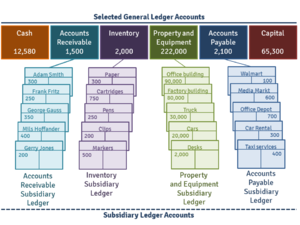Subsidiary account: Difference between revisions
From CEOpedia | Management online
Ceopediabot (talk | contribs) m (typos fixed: oportunity → opportunity, ’s → 's (2)) |
mNo edit summary |
||
| Line 23: | Line 23: | ||
* a vendor record that belongs to accounts payable ledger. This type of subsidiary account provides the detail for the amount that is indebted to specific suppliers. | * a vendor record that belongs to accounts payable ledger. This type of subsidiary account provides the detail for the amount that is indebted to specific suppliers. | ||
* a [[customer]] record that belongs to accounts receivable ledger, that in its turn includes the transactions on the accounts’ receivable control account in the aforementioned general ledger. This subsidiary account lists amount of [[money]] that is indebted to the [[company]] by specific customers. | * a [[customer]] record that belongs to accounts receivable ledger, that in its turn includes the transactions on the accounts’ receivable control account in the aforementioned general ledger. This subsidiary account lists amount of [[money]] that is indebted to the [[company]] by specific customers. | ||
[[File:subsidiary_account.png|300px|right|thumb|Fig.1. General and Subsidiary Ledger Accounts example]] | |||
==Purpose and uses== | ==Purpose and uses== | ||
Revision as of 15:08, 26 August 2020
| Subsidiary account |
|---|
| See also |
Subsidiary account - is an account that keeps track of any information concerning transactions through accounts receivable and accounts payable. Subsidiary accounts are linked in a subsidiary ledger that in turn is summarized under a general ledger.
A subsidiary account is a part of a three-level system that controls all the transactions occurring in the entity[1]:
- lowest level: subsidiary account (constituting the part of a subsidiary ledger);
- next-lowest level: subsidiary ledger (the aggregated total number of them enter the control account);
- highest level: control account (one of the parts of the general ledger).
Examples of subsidiary account[2][3]:
- a vendor record that belongs to accounts payable ledger. This type of subsidiary account provides the detail for the amount that is indebted to specific suppliers.
- a customer record that belongs to accounts receivable ledger, that in its turn includes the transactions on the accounts’ receivable control account in the aforementioned general ledger. This subsidiary account lists amount of money that is indebted to the company by specific customers.
Purpose and uses
Subsidiary account has the following functions[4]:
- The essential function of a subsidiary account (ledger) is controlling customer payments and avoiding overpayment and other accounting instances. Since accounting relies on details, the balance sheet may help to reveal the problems of over-/underpaying.
- Another function of subsidiary accounts (ledgers) is to reveal embezzlements and internal corporate fraud. Subsidiary ledgers can prevent such fraud schemes as: fictitious receivables offset, lapping, borrowing against receivables using accounts as a collateral one, adjoining one client's payment to another client's account to disguise theft.
- Project management functions are also provided by the use of a subsidiary account (ledger) since it helps to manage accounts that finance each separate project. If a company caters for a number of customers, its subsidiary accounts are divided by customers and they show what service the customers choose the company for. Having subsidiary accounts, the companies can stay aware of the amount of money indebted and for which service.
- Aging subsidiary accounts is a tool used by business owners to check their clients’ reliability and detect defaulted accounts. The report on aged accounts demonstrates for how long the clients have owned money, what the total debt sum is and which client past due. This tool and the subsidiary ledgers are of the utmost importance for the business and its proper management of accounts receivable. Without subsidiary accounts a business owner cannot have the complete information about customers that owe money for an extended period of time (the amount receivable can be, for example, 30, 60, 90 days old).
- A better demographic and geography-wise targeting – is another opportunity a subsidiary account provides. The control and analysis of a whole subsidiary ledger provides invaluable information for a business management: it can help to define consistency in payment of each region, reliability remittance of different age groups and the biggest sources of cash flow for a business.
Benefits
The benefits of having an subsidiary account are as follows[5]:
- Subsidiary accounts can demonstrate in one account transaction how a customer or creditor were affected, providing business owners with up-to-date information on specific balances.
- They eliminate unnecessary excessive details from general ledger; thus, the latter is not overloaded with vast numbers of individual accounts.
- Eliminations of errors in individual accounts by the implementation of control accounts or reduction of accounts in a ledger.
- Enables division of labour in introducing new numbers to the ledger. An employee from one department can post to subsidiary ledger, while another can post to the general ledger.
Drawbacks
The disadvantages of having an subsidiary account are as follows[6]:
- All the functions of a subsidiary account require additional legal and accounting operations.
- Tedious procedures increase bureaucracy.
- Since subsidiary accounts require specific documentation – the financial statements become more complex.
- The company is liable for subsidiary's criminal actions and debts.
Footnotes
References
- Bragg S. M. (2005) , Inventory Accounting: A Comprehensive Guide, John Wiley & Sons, Inc.
- Epstein B. J., Jermakowicz E. K.(2010) Interpretation & Application of International Financial Reporting Standards, John Wiley & Sons, Inc.
- Lerner J. J. (2004) Schaum's Easy Outline Bookkeeping and Accounting, The McGraw-Hill Companiec
- Perri A. (2015) Innovation and the multinational firm: Perspectives on Foreign Subsidiaries and Host Locations, Palgrave Macmillan
Author: Kamil Piszczek
